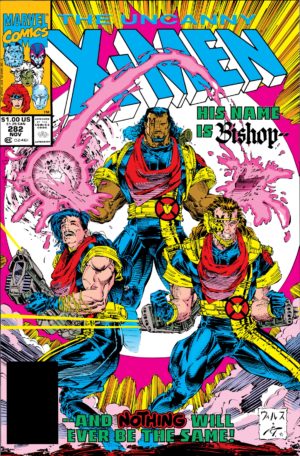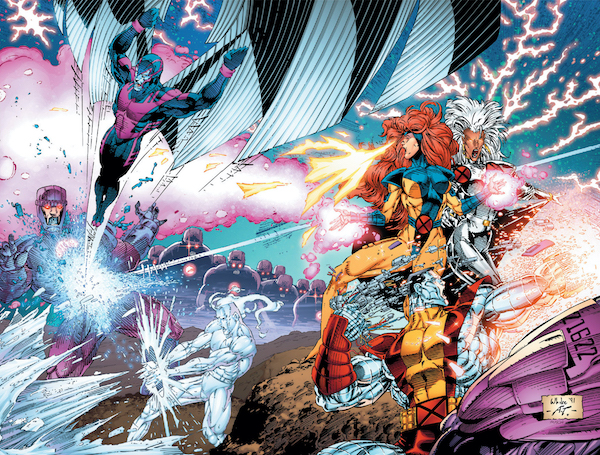What?! Two days of Crushing Comics guide updates in a row? Your eyes do not deceive you, folks! After digging into a comprehensive update to guide that started it all, Uncanny X-Men’s Claremont era, I couldn’t help myself from charging onward to the next era of the title! Did you know that from 1991 to 2000 Uncanny X-Men featured no less than 16 direct crossovers and events?! They’re all covered by my Guide to Uncanny X-Men in the 90s – The Crossover Era.
Guide to Uncanny X-Men in the 90s – The Crossover Era
That image is the recolored cover of Uncanny X-Men (1963) #281, the first issue after Chris Claremont’s historic 16-year run on the title.
That was the comic that greeted me face-to-face when I walked into a comic book store for the first time at the age of 10. I had already started grabbing copies of its sibling title, X-Men (1991), off of the spinner racks in mall bookstores. But, X-Men’s popularity was at its peak during a rise in speculation, and even an issue from just a few months prior was already nearly $10!
There is so much new and accumulated plot in this one issue of X-Men that I wish I could go back to record my reaction to reading it live. Jean Grey, who apparently died before, died again! An entire class of young students were slaughtered, along with their instructor who was also apparently really into BDSM, Emma Frost. And there were giant purple robots and green-haired mutants from the future.
IT WAS WILD! And, I loved it – then and forevermore.
If X-Men (1991) #3 was the issue that reeled me in from the spinner rack in the mall, this was the issue that solidified my near-instant dedication to the X-Men franchise. They both had in common covers that put a cast full of women front and center in the action alongside men – something I had rarely seen in kid-oriented media at the time.
Ultimately, I hung on as a monthly reader of Uncanny X-Men in the 90s for less than 50 issues – my enthusiasm defeated by Onslaught, being a teenager, and needing money to run my 28k internet connection.
If I and other readers of all ages felt that the crossovers were out of control in the early half of the 90s, it wasn’t our imaginations running wild. From just 1992 to 1994, Uncanny X-Men featured X-Cutioner’s Song, Fatal Attractions, BloodTies, Phalanx Covenant, and LegionQuest – which lead into Age of Apocalypse! (Plus, the X-Men/Ghost Rider crossover in adjectiveless X-Men.)
It’s no wonder I was burnt out when I quit comics back in 1996. But, the crossover era pressed on without me starting from issue #338. For the next 50-plus issues, Uncanny X-Men and X-Men (1991) often acted as two halves as a single twice monthly title, with stories ping-ponging between them. There were also a slew of other formal crossovers, including Hunt For Xavier, X-Men vs. Apocalypse, Powerless, Revolution, Dream’s End, Eve of Destruction, and more!
I updated this Guide to Uncanny X-Men in the 1990s relatively recently, so the only huge revelation to report is the 2022 breaking news that X-Men Epic Collections have finally extended past the end of Chris Claremont’s run to press farther into the 90s. We already have a pair of Epic Collections out for this era with a third on the way in a few months. So far it looks like Marvel is committed to collecting both Uncanny X-Men and X-Men (1991) into a single series they way they day with Star Wars Legends titles – and, unlike their approach to Spider-Man.
While every single issue in this era has been reprinted, those reprints must be puzzled together in a mix of paperback and oversize hardcover formats to create a complete physical reading experience. Epic Collections will be a welcome solution to that, and the time is right for them to press past Age of Apocalypse into the Onslaught era, because the “Road to Onslaught” paperbacks are about to be a decade old!
It’s intensely satisfying to revisit this Guide to Uncanny X-Men in the 1990s – The Crossover Era. and be reminded that Marvel has completely collected this decade of intense crossovers. When I first started collecting in 2010, this era was full of massive gaps! Now, it’s all about making it even more accessible in a single stream of Epic collections (as well as filling in a pair of gaps in oversize coverage).
